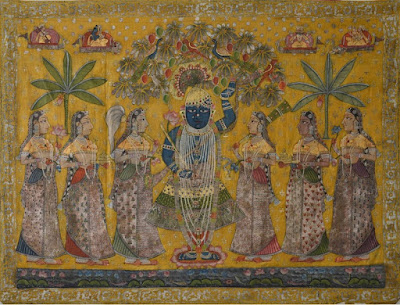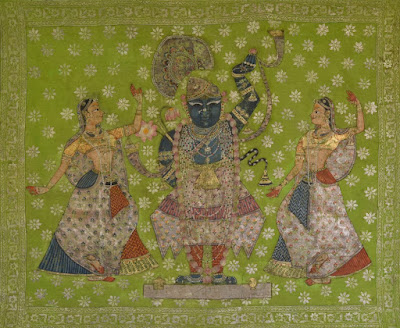Glimpses of Krishna: Pichwai Art's Fascination with Lord Shrinathji
Exploring the Divine Narrative: Pichwai Art's Reverence for Lord Shrinathji
Introduction
Pichwai art, a traditional form of Indian painting, has long been celebrated for its intricate detailing, vibrant colors, and captivating depictions of religious themes. One of the most enchanting subjects within Pichwai art is Lord Shrinathji, an incarnation of Lord Krishna. This blog delves into the world of Pichwai art, uncovering its deep-rooted fascination with Lord Shrinathji and the spiritual narratives it portrays.Understanding Pichwai Art
Originating in the town of Nathdwara, Rajasthan, Pichwai art is a centuries-old tradition that adorns temple walls and sanctuaries. Derived from the Sanskrit words 'pich' (back) and 'wai' (textile), Pichwai art was traditionally created on large pieces of cloth that were used as decorative backdrops behind the idol of Lord Shrinathji. These artworks not only add to the aesthetic beauty of the sanctum but also narrate stories from Lord Krishna's life.A Glimpse into Shrinathji's World
At the heart of Pichwai art lies an ardent devotion to Lord Shrinathji. The paintings often depict Shrinathji in various postures, adorned with exquisite jewelry and vibrant attire. The artists pay meticulous attention to detail, showcasing the intricate folds of the deity's garments and the expressive features that convey divine grace.Depicting Spiritual Narratives
Pichwai artworks are more than just visual delights; they are powerful mediums for conveying spiritual narratives. The fascination with Lord Shrinathji stems from his role as a child deity, embodying the essence of innocence and playfulness. Artists use Pichwai paintings to depict various stages of Krishna's life, from his mischievous childhood antics to his divine interactions with nature and devotees.Symbolism in Pichwai Art
Every element in a Pichwai painting holds significance. The lush landscapes, intricate patterns, and even the positioning of Shrinathji communicate deeper meanings. The 'Pichwai' itself signifies an offering to the deity, symbolizing the devotee's dedication and adoration. The art often revolves around festivals and seasons, adding a temporal dimension to its visual storytelling.Preserving Tradition through Pichwai Art
In an ever-evolving world, Pichwai art stands as a guardian of tradition. The artists, often belonging to generations of skilled craftsmen, pass down their techniques and knowledge to maintain the authenticity of the art form. Pichwai art's fascination with Lord Shrinathji isn't just about capturing a religious figure—it's about preserving cultural heritage.Pichwai: From Temples to Global Recognition
While Pichwai art originated as temple decor, its allure has transcended sacred spaces. Collectors, enthusiasts, and art connoisseurs from around the world now admire and collect Pichwai paintings. This global recognition has not only elevated the status of the art form but also ensured its survival for generations to come.Conclusion
Pichwai art's fascination with Lord Shrinathji is a testament to the profound connection between spirituality and artistic expression. Through intricate brushwork and vibrant colors, Pichwai artists capture the essence of devotion, preserving the stories and teachings of Lord Krishna for eternity. As Pichwai art continues to enchant individuals worldwide, its vibrant glimpses into Krishna's divine world remain an integral part of India's cultural and artistic tapestry.Intricately woven into the fabric of Indian heritage, Pichwai art's devotion-filled brushstrokes continue to paint a vivid picture of Lord Shrinathji's timeless grace.
Experience divine traditions online at beyondsquare.in. Explore and purchase exquisite Shrinathji's Pichwai and more, capturing spirituality in art













Comments
Post a Comment